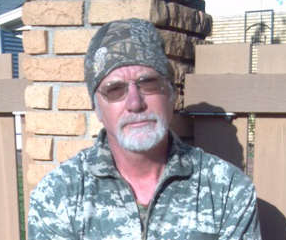
The directions to a desolate farmstead northwest of Syracuse led me through mile-after-mile of huge open crop fields and immense rocky pastures where the only green plant life seemed to be seas of thriving Yuca. Occasionally, buildings appeared on the horizon several miles away only to disappear behind the next hill. If I wasn’t in the middle of nowhere, it was certainly just over the next rise.
I traveled here to spend a couple days with a friend, John Borror and to help him on his western KS trapline. There in cattle country, ranchers rely on trapping to help control coyotes and other predators that prey of young spring calves. I finally spotted the grain bins he told me to look for and drove back a long dusty lane to find his trailer set up in front a big hay shed. He converted a long horse trailer into living quarters in the front and storage for freezers and trapping supplies in the rear.
John has trapped around his home in southeastern KS since he was a kid. When he married and started a family, his responsibility as a husband and a dad, plus a full-time job forced a lot of his trapping to be done in the dark, either before or after work. In 2010, with his 4 girls long-since on their own, and retired from his job, John began pursuing a dream of running long, extensive trap lines in other states. The first was in Arizona, then New Mexico and Texas and this was his third-year trapping around Syracuse, KS.
Each morning was a new adventure as we wound our way from trap site to trap site. Traps near the barely-flowing Arkansas River yielded mostly bobcats and an occasional coyote that travel the weedy field edges and tractor paths lined with dead tamaracks as they hunt for rabbits and other small game. Farther from the river, traps placed along crop land where field edges meet weedy cover or CRP, and in field corners that are natural “funnel” areas from one type of habitat to another, catch traveling coyotes, swift foxes and badgers. In the immense, sprawling, rocky rolling tracts of land known in that country as pastures, traps set at gateways, along cattle trails and in corners also catch coyotes, swift foxes and badgers. All these trap sites also attract occasional skunks that live in borrowed burrows, and raccoons that live who-knows-where since trees out there are as scarce as rain. At last estimate, John has trapping permission on nearly 40, 000 acres of land around the Syracuse area. One wonders how that amount of land could be trapped, but a 1,000-acre pasture might only have suitable sites for ten or a dozen traps, mostly at gateways and around edges.
At the end of each day, animals are skinned and the pelts layered carefully in a big freezer until he can finish them later. Numerous other parts of the animal are used also; various glands are harvested for making predator trapping bait, skulls of all animals except coyotes are kept to be cleaned and sold to colleges for studies and to collectors, entire bobcat carcasses are frozen, also to be used in making predator bait and bobcat paws are kept for sale to jewelry makers who use the claws.
John figures he has harvested well over one thousand animals on his extensive out-of-state and western KS trap lines. The most exciting was a mountain lion caught in Arizona that was released back into the wild with the help of Arizona wildlife officers. John has also put together a collection of more than 350 antique traps that can be seen at the Wilson County Old Iron Club in Fredonia, KS.
When I asked him why he travels all those miles to trap, he replied “From my years of trapping at home, I know each year where I will set each trap, and it gets repetitive, more like a job, so I like to see and trap new places.” When I left John a week ago, he had caught 70 coyotes, 9 badgers, 8 raccoons, 6 swift foxes, 6 skunks and a porcupine. Wild fur is a self-sustaining crop that will yield these same number of animals each year, forever, if properly managed…Continue to Explore Kansas Outdoors.
Steve Gilliland, Inman, can be contacted by email at [email protected].






